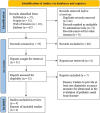Diagnostic utility of ultrasound in pediatric nasal bone fractures: a systematic review and meta-analysis
- PMID: 38538882
- PMCID: PMC11130032
- DOI: 10.1007/s10140-024-02225-1
Diagnostic utility of ultrasound in pediatric nasal bone fractures: a systematic review and meta-analysis
Abstract
Ultrasonography, a radiation-free and cost-effective modality, stands out as a promising tool for evaluating nasal bone fractures. Despite limited literature on its pediatric application, there is an increasing recognition of its potential to enhance diagnostic precision. To evaluate the diagnostic efficacy of ultrasound in detecting pediatric nasal bone fractures. Employing established guidelines, a systematic review and meta-analysis were conducted through a comprehensive literature search in PubMed, Scopus, Web of Science, and Embase databases until December 5, 2023. Inclusion criteria encompassed studies reporting diagnostic accuracy measures of ultrasound in pediatric patients with nasal bone fractures. Data extraction and analysis were undertaken for the selected studies. Involving four studies with 277 patients, ultrasound demonstrated a pooled sensitivity of 66.1% (95% CI: 35.1-87.5%) and specificity of 86.8% (95% CI: 80.1-91.4%) in diagnosing pediatric nasal fractures. The area under the receiver operating characteristic curve (AUC) was 0.88 (95% CI: 0.72-0.93). After excluding an outlier study, sensitivity and specificity increased to 78.0% (95% CI: 65.6-86.9%) and 87.8 (95% CI: 78.1-93.6%), respectively, with an AUC of 0.79 (95% CI: 0.75-0.94). Pooled positive and negative likelihood ratios were 5.11 (95% CI: 2.12-9.15) and 0.40 (95% CI: 0.14-0.77) before exclusion and 6.75 (95% CI: 3.47-12.30) and 0.26 (95% CI: 0.15-0.40) after exclusion of an outlier study, respectively. This study highlighted ultrasonography's utility in diagnosing pediatric nasal bone fractures with high accuracy and specificity. However, caution is advised in relying solely on ultrasound due to suboptimal overall diagnostic performance, evident in likelihood ratios.
Keywords: Fractures; Nasal bone; Pediatrics; Ultrasonography.
© 2024. The Author(s).
Conflict of interest statement
The authors have no competing interests to declare that are relevant to the content of this article.
Figures





References
Publication types
MeSH terms
LinkOut - more resources
Full Text Sources

